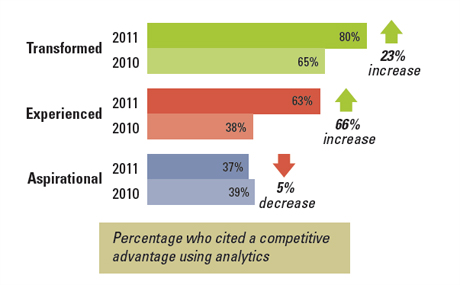
Along the Great Analytics Divide
Unless you’ve been stowed away from all technology news for the last several months, you’re probably well aware that the phrase “big data” is becoming increasingly tied to the concept of enterprise competitiveness.
 This is not a new idea, of course. Most major enterprise players in data-centric verticals have long tied their competitive ambitions to the speed of their networks and hardware as well as the differentiations in their software approaches.
This is not a new idea, of course. Most major enterprise players in data-centric verticals have long tied their competitive ambitions to the speed of their networks and hardware as well as the differentiations in their software approaches.
Now, however, there is a new game in town; it’s the hardware, software, but now the very data itself that is at the heart of a competitive edge. What this means isn’t just the amount or even usability of the data alone—it’s being able to chew through it in real-time, despite the fact that it is in different formats and doesn’t fit neatly into the traditional models of handling data of any size.
This issue of competitiveness based on analytics capabilities (put the emphasis on cutting-edge analytics here) was at the heart of a recent study from the MIT Sloan Management Review and the IBM Institute for Business Value.
The study gleaned insights from 4,500 managers about what separates those who use analytics for a competitive advantage from those who don’t—and revealed some notable patterns about what is increasingly separating the analytical wheat from the proverbial chaff.

The authors separate organizations who have adopted advanced analytics into two camps: transformed versus untransformed (purposefully making those who have yet to implement such strategies sound malformed or not evolved) and point to a number of case studies that put analytics value in context. For example, by pointing to advances made by companies like BAE and Pfizer, the authors highlight how competitive value is achieved through analytical capability.
 In the report (registration required for the 22 pages with case studies), the authors contend that “big data, and the fast pace of complexity of today’s marketplace, require that leaders make decisions faster than ever before.” They say that almost 70% of the CEOs they spoke with said they faced serious volatility and uncertainty and expect more down the line. However, they say that the “transformed organizations keenly appreciate the value of more precise and near real-time decisions and are three times more likely than Aspirational [those who see the value of advanced analytics but haven’t made the leap] organizations to focus intensely on the speed of decision making.”
In the report (registration required for the 22 pages with case studies), the authors contend that “big data, and the fast pace of complexity of today’s marketplace, require that leaders make decisions faster than ever before.” They say that almost 70% of the CEOs they spoke with said they faced serious volatility and uncertainty and expect more down the line. However, they say that the “transformed organizations keenly appreciate the value of more precise and near real-time decisions and are three times more likely than Aspirational [those who see the value of advanced analytics but haven’t made the leap] organizations to focus intensely on the speed of decision making.”
This is actually the second in their series of studies that examine the role analytics are playing at large organizations. For instance, at the time of this year’s survey, 58% of the enterprise managers surveyed were using some form of analytics to gain a competitive edge. This year’s study marked a 37 percent increase in those saying that analytics were core to their competitiveness—a rather dramatic rise when we think about other trends in IT.






























